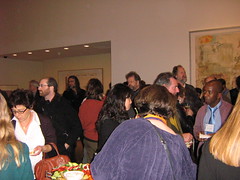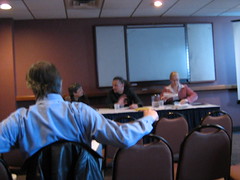Paweł spoke about Digitized consciousness in Cyberpunk, specifically focusing on Richard Morgan‘s work. It was a really good close reading (for a change!) because Paweł gave a sufficient introduction the the main things we needed to know about the books to follow the argument, then managed a good balance between general claims and specific examples and explanations, and then made clear why understanding what Morgan was doing is useful. –Because Morgan reinstates the body in the Cyberpunk genre in which it has been traditionally deprecated. And, even better, we learn that one reason for Morgan’s doing this is (probably) his Marxist beliefs that of course lead him to think that material circumstances, including embodiment, are of inescapable importance. The economic and political aspects of this fiction sound really cool, and after wards Paweł was raving (a little) about Morgan in the way I know I do about authors I think are just the best, so now I will have to read him for sure. (Follow up: started Woken Furies and really like it. Look for a review in Tart next month.)
The next panel I went to had papers about SciFi heavy metal; the way Shelley’s Frankenstein and Huxley’s Brave New World are used in debates over cloning; and about the way gadgets are used in films to represent cognition (essentially).
The heavy metal presentation was clear in the way it explained how lyrics, compositional choices, and visual style were used to communicate fears and hopes about technology, but I wish there had been a bit more explanation of the “so what” aspect. I mean,what does this tell us about ourselves, about heavy metal, about our experiences of and attitudes toward technology? Some of that came out in questions, but should have been part of the conclusion, I think.
The cloning discussion was a quite good rhetorical analysis of public debate over cloning–if I were still at MIT it would have been a perfect text for my science writing class. In particular, two important tropes were explored: the monster in society — the mere existence of a clone will destroy us — and society as monstrous — cloning means we have turned into the hellish thing we feared. (And as a corollary will of course enslave and otherwise mistreat the poor clones.)
Finally, a presentation about the brain and memory being represented as a file system and video clips in many many films. Most interesting points: this represents a focus on use rather than architecture, and “gadgets are a technology of the imagination for ordering the imagination.”
After this panel, there was another reception at which I hung out with Paweł, Christian, and Sherryl Vint (for who I can’t find a personal website, so far) and I think this is where I also first met Istvan Csicsery-Ronay...but no, we were introduced at some point earlier…well anyway. Then we went in to see N. Katherine Hayles. Since she gave the exact same speech as when I saw her at Utrecht, I won’t go over it again. Paweł and I muttered a little about that as she hit each familiar point, while trying to stay awake. –The latter got easier when they turned on air-conditioning and it got really chilly. I guess I don’t really see anything wrong with it; no one else ever heard it before and it’s a pretty good talk.
I was then swept up into a mob of the SFRA folks and we went for Indian food. Really good conversation with Istvan, Paweł, and Jason Ellis. Really glad to have met Istvan and had the chance to talk politics, SF, and teaching, all in the same conversation. This makes me realize how much I miss being able to do that most of the time.
Finally we washed up at the Holiday Inn bar for some drinks and more talking, and so ended the day.

